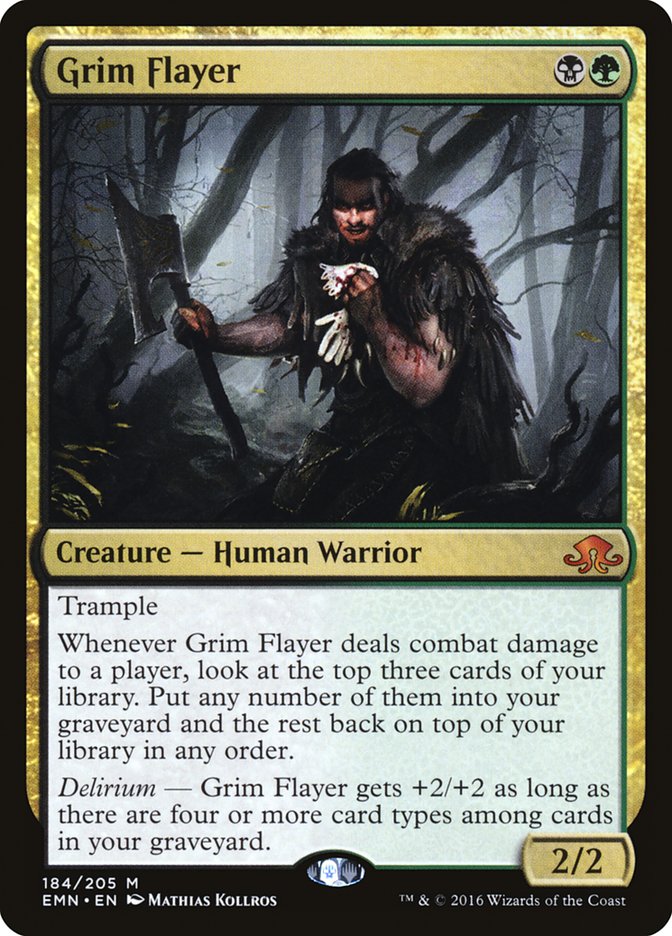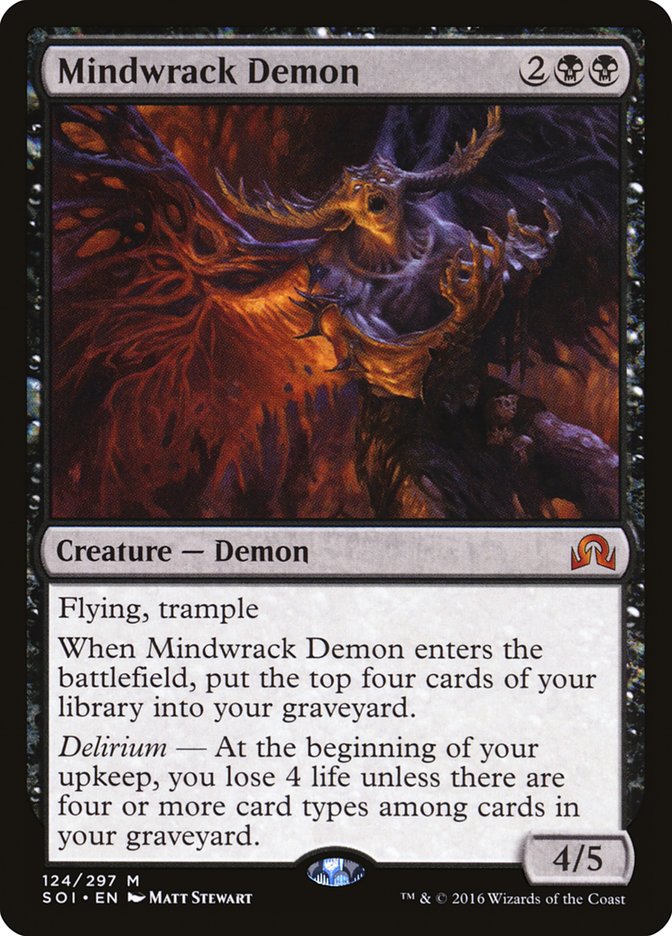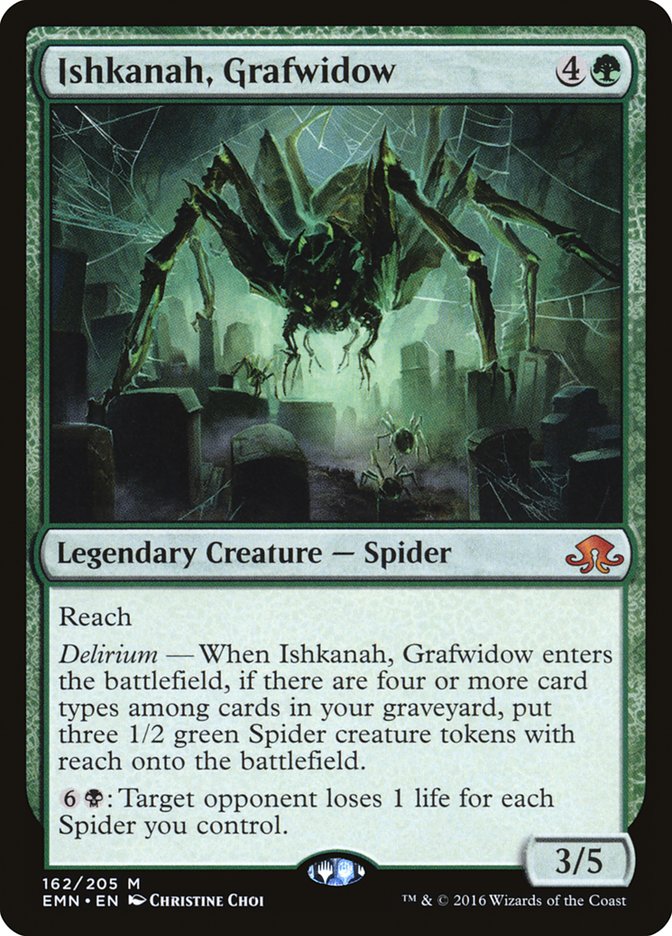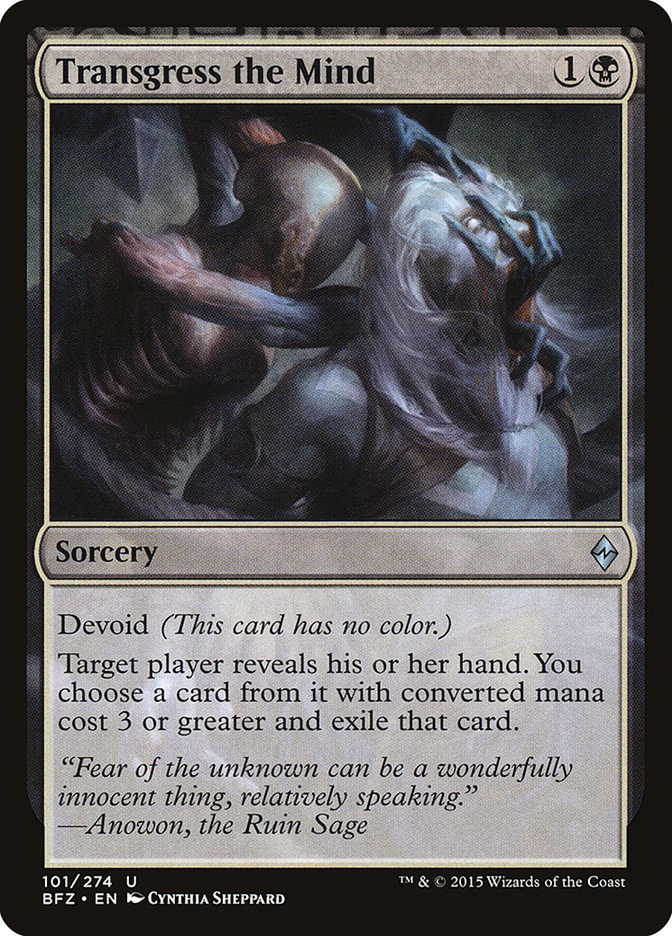Last week I wrote about whether or not B/G Delirium was the best deck choice for #SCGKNOX. I guess you could say I had chosen wisely. I ended up winning the whole event, netting me my ninth Open Top 8 as well as my second trophy on the circuit. Above all of that, I got 30 precious SCG Points that throw me right back into the mix of things for Season Three. Up to now I only thought of playing in my third Players’ Championship as a dream, but now it’s more tangible than ever, as others have to catch me and not the other way around like it’s been for most of the season. Things are looking good going into the #SCGINVI, and it’s all thanks to B/G Delirium!
The tournament itself went smoothly. B/G Delirium is clearly the format’s front-runner for best deck, but that wasn’t the popular belief going into the event…and said popular belief was certainly the reason for my success. Many of the big names on the circuit believed W/U Flash to have a superior matchup against B/G Delirium up to this point, but talented B/G Delirium players saw it the other way around. I predicted this level of self-confidence to show up from both sides, and it was exactly what I needed to happen if I wanted a good finish.
You see, the matchup between W/U Flash and B/G Delirium is complex at all stages of the game. One small misstep on either side can end in the game spiraling out of control. It’s difficult to play so well for that long in any tournament, which is why we’ve seen so many of the circuit’s best and brightest pilot W/U Flash to consistently strong finishes. There is an argument to be made that they could still have those same finishes with B/G Delirium, but W/U Flash is much better against the format’s fringe decks like Aetherworks Marvel or G/R Energy. In all honesty I don’t fault them for playing the deck up to this point, nor moving forward, but they should now understand who’s actually in charge here.
Creatures (15)
- 2 Pilgrim's Eye
- 3 Mindwrack Demon
- 1 Tireless Tracker
- 1 Emrakul, the Promised End
- 3 Ishkanah, Grafwidow
- 4 Grim Flayer
- 1 Noxious Gearhulk
Planeswalkers (4)
Lands (23)
Spells (18)

Things have to go right to win a tournament, and many things did for me this past weekend. The biggest boon was my matchups throughout the tournament. Outside of Round 2 and the finals, the only two matchups I played all tournament long were either B/G Delirium or W/U Flash. For those counting, that’s a grand total of sixteen out of eighteen matches against only two different decks. That’s a first for me, since I can’t even tell you exactly how many of each matchup I played; they’ve all blurred together now, looking back on the tournament. There was more diversity back in the Devotion Dark Ages and Eldrazi Winter than there was last weekend for me! The biggest benefit for this level of redundancy is that I now feel like I’ve mastered the matchups and want to share everything I know.
W/U Flash
A common trend you’ll notice in this article is just how good I think Grim Flayer is on the play. It’s not even bad on the draw in this matchup unless they have Reflector Mage into Gideon, Ally of Zendikar.
I’ve yet to find a hand worth mulliganing in this matchup that allows for me to play it on turn 2. It’s just that good. From there you will be able to sculpt your draws while putting pressure on your opponent but also have a very clean route to delirium so that your Ishkanah, Grafwidow can be cast on turn 5 without needing a turn to set her up.
The best part about having a Grim Flayer in these games is that they will have to react to the card with either Reflector Mage or Stasis Snare instead of holding up countermagic or spending their time setting up and protecting a Gideon, Ally of Zendikar. This window should allow for you to either set up for Ishkanah, Grafwidow the turn after they slam Gideon, Ally of Zendikar or safely get Mindwrack Demon onto the battlefield.
It’s very difficult for them to beat Grim Flayer on the play because of all of these situations. Without a battlefield advantage in the early turns, W/U Flash has a tough time leveraging their powerful cards like Gideon, Ally of Zendikar or Archangel Avacyn in the later ones. They will spend most of their time trying to find a window to gain an advantage, but with careful timing you’ll stop them from being able to do so.
You are the more powerful deck as the game goes long. This means you should not be afraid to trade resources, but don’t just walk into traps willy-nilly. You also can’t just sit there and let them sculpt a sequence that will put them too far ahead on the battlefield given their powerful tempo-based capabilities. Make trades, but controlled ones. Something I like to do when I have a position advantage with, let’s say, a Grim Flayer is to tap out pre-combat for one of my more powerful cards like Ishkanah, Grafwidow into five untapped mana. If it resolves, I won’t attack, but if it doesn’t, I get a clear combat step without fear of Archangel Avacyn. Don’t just throw away a Grim Flayer to resolve an Iskanah, Grafwidow. We play so many copies of this mythic spider that we can afford to let one get countered when we are ahead.
Some games will come down to Gideon, Ally of Zendikar on one side with Ishkanah, Grafwidow on the other. These games can become rather complex, since attacking is out of the question from our side. That’s usually because we couldn’t do so in the first place, which is why Gideon, Ally of Zendikar survived.
This is when we must call for Emrakul, the Promised End to do just that. Chump block aggressively while making land drops and building a battlefield presence. It’s even correct to block with Ishkanah, Grafwidow herself so that you can recast her thanks to Grapple with the Past or Liliana, the Last Hope. Don’t go to crazy on Spider accumulation, though, given they can simply sweep the battlefield with an Avacyn flip. You always want to insure you will have another Ishkanah, Grafwidow to follow up this Hail Mary attempt to steal a game from the W/U Flash side, and you rarely need more than four Spiders to burn them out with her ability anyway.
A medium-sized battlefield will usually be enough for your Emrakul, the Promised End turn to dismantle any type of offense from them. You don’t even need Emrakul, the Promised End to win the game, since most of the time she will find herself under a Stasis Snare anyway. You just need the turn of meddling to force them to rebuild using draw steps. At that point, our deck should do what it does best, which is have better topdecks, and utilize a high density of lands better than they can. Remember: they flood out while we don’t. Thanks, Ishkanah, Grafwidow!
Sideboarding
Out:
In:
I don’t actually have a radical shift in how I sideboard in this matchup that depends on the play or draw. It mostly comes down to what I predict out of my opponent, and this was how I eventually settled on how to sideboard against most of my opponents last weekend.
They took a much harder control approach than I originally thought they would, so I had to readjust in what I was doing. I came into the weekend expecting to have Tireless Tracker on the play while sideboarding it out for more reactive measures when on the draw. Then I began to notice they were mostly taking a more controlling approach with Jace, Unraveler of Secrets; counterspells; and removal. I began to treat them more like a midrange deck than an aggressively slanted tempo deck as I initially did.
I’m scared of one thing and one thing only in this matchup, and that’s Gideon, Ally of Zendikar. Whether they take an aggressive stance before this planeswalker comes down or a controlling one after, it’s easy for them to find a path to victory with this card on the battlefield. The first priority is to invalidate this card’s effect on the game; then and only then can you really focus your energy on other things. It’s easier on the play than the draw, since you can either get a battlefield presence advantage or simply slam Ishkanah, Grafwidow right after the planeswalker comes down, but it can be difficult on the draw. That’s why I like to rely on Transgress the Mind to do some of the heavy lifting for me. I’ll gladly take a hit from an early Smuggler’s Copter if it means I can strip a Gideon, Ally of Zendikar out of their hand. It’s just that important on the draw.
The games get a little bit more difficult in the mid- to late-game, given they have better answers for our Ishkanah, Grafwidows. Spell Shrivel is practically a hard counter given how long a game has to go before we get out of its range. This doesn’t mean you still shouldn’t run yourself into one if the situation calls for it, but make sure you are okay with the outcome before you do so. One thing that commonly does come up is their aggressiveness with Reflector Mage. Given that they have better counterspells, they will more aggressively use their bounce to tempo out Ishkanah, Grafwidow. This is a perfect place to be if you have a Transgress the Mind you haven’t found a good time to use yet, since now it can grab the counterspell they planned to use on Ishkanah, Grafwidow when you tried to recast her.
B/G Delirium
Being on the play presents many advantages in this matchup as long as those resources are present. Being the first player to either Grim Flayer or Liliana, the Last Hope can vastly slant the advantage to the player. One of the most important aspects of being on the draw is having the Grasp of Darkness available for the turn 2 Grim Flayer an opponent might present. Now, this doesn’t completely decide if a hand is keepable, but it does influence my decision if I at least can deal with their Grim Flayer or not. I will keep a powerful hand without a removal spell on the draw, but it has to be very good to do so. Usually it means I can either put my own Grim Flayer on the battlefield or sacrifice a Vessel of Nascency on turn 2 and begin sculpting my own late-game.
If you happen to be the one connecting with Grim Flayer, it is important to not get too greedy with the card’s ability to manipulate the top of your library. One thing I saw my opponents doing was prioritizing Grim Flayer as a means to an end when it should just be an advantage you have that gets you superiority in the late-game. It’s important to make sure you get to hit your land drops regardless of early battlefield position with Grim Flayer or Liliana, the Last Hope. Grim Flayer will eventually either win you the game without much help or become invalidated by Ishkanah, Grafwidow, at which time you should transition away from being aggressive and begin preparing for Emrakul, the Promised End.
Knowing when to cast Emrakul, the Promised End can be tricky in the mirror. More often than not, it’s important to simply be the first to cast the card, since you will be able to decimate their battlefield before they have a chance to do the same to you, but one important measure should be in place before you do so. It’s vital that you will be able to either deal with their Emrakul if they have it in their hand and the capability to cast it or be able to cast yours a second time after they resolve and deal with yours.
You see, it’s easy to kill their Emrakul, the Promised End with yours if someone has a Liliana, the Last Hope on the battlefield or you have Pilgrim’s Eye or a Spider token ready to soak up thirteen damage in combat. This makes it important to do some serious damage to the battlefield with the first Emrakul, the Promised End, or else it will end up being better to be the second person to cast it. Sometimes it’s just better to Traverse the Ulvenwald for Emrakul, the Promised End but not cast it and continue building an advantage somehow if you know they will not do detrimental damage with their own.
Because of how weak Emrakul, the Promised End can be against a measly Spider token, it’s important to prioritize Ishkanah, Grafwidow in the matchup. It’s shocking to me how many times I had unlimited options in how I could approach my turns but always chose to just cast another Ishkanah, Grafwidow and “see what happened.” The card is just busted even in the mirror match!
Sideboarding
On the draw:
Out:
In:
Grim Flayer doesn’t pack the same punch on the draw, which is why I just get rid of it. You want to spend your time fueling delirium, reacting to their permanents, and using hand disruption to make sure they don’t gain too much of an advantage in the mid-game regardless of what it is. You would think Pick the Brain is best used against Emrakul, the Promised End, but even taking Ishkanah, Grafwidow out of their deck completely will make it very difficult for them to win any game where dust has a chance to become settled.
On the play:
Out:
In:
This is one of the most important midrange lessons you may ever learn, so stay with me. I don’t even feel comfortable giving out this information for the umpteenth time, given how much money it has made me over the past few years, but people don’t seem to listen to me anyway, since they still do one of the worst things you can do in a midrange mirror in Standard.
Don’t be too reactive on the play.
Just because you have access to “good” cards like hand disruption doesn’t mean you should use it all when on the play. Your advantage for going first is being the first one to the battlefield, so make sure you can do exactly that. This means more permanents and fewer removal spells/hand disruption for theirs, because they will have fewer permanents in their deck to better beat up on yours. If you draw too much removal, they will get to steal the “advantage” of you going first, and the blame can only be put on yourself.
I’ve seen some of the game’s greats make this mistake against me throughout the years, most recently when Jeff Hoogland was on the play this past weekend in the mirror. He mulliganed, which set him back, but an early Transgress the Mind let me see his hand was only removal spells and one proactive element that I exiled. I readjusted my gameplan and easily won, since I forced the game to prioritize other things.
To internalize this, you must understand role assessment and the difference between aggressive/defensive and proactive/reactive. W/R Vehicles is an aggressive deck that is trying to capitalize on its early aggressive elements to find a path to victory. W/U Flash is a proactive deck trying to gain further edges that can be gained by its proactive tempo-based elements. That involves forcing players to walk directly into Archangel Avacyn or counterspells because you’ve forced them to.
In a midrange mirror, one player is trying to be proactive while the other is forced to be reactive due to being on the back foot, which is a product of going second. You don’t take an aggressive or defensive stance, but a proactive or reactive one. If your opponent is no longer presenting proactive plans, you can then transition to being the proactive one by presenting threats like Mindwrack Demon; Liliana, the Last Hope; Tireless Tracker; or Ishkanah, Grafwidow. You don’t need to continue being the control player, because you were never that to begin with.
Being on the play in the mirror does give you the advantage of playing and dealing damage with Grim Flayer, but that doesn’t make you the aggressor in the matchup. You simply have an advantage that you need to leverage when the game transitions away from being about the Grim Flayer. It also doesn’t mean you have to continue being aggressive with other elements as well. Use these triggered abilities as a way to sculpt the perfect mid-game, which involves making land drops to set up Ishkanah, Grafwidow and eventually Emrakul, the Promised End. Don’t pigeonhole yourself into finding more Grim Flayers and removal to hopefully win the game with these attacks. It will not pan out the way you’d hope more often than not, and usually it will end in your demise if you stop advancing your battlefield with things that matter thanks to putting too many lands in your graveyard.
For now, I don’t know what I want to do about updating the deck. The Invitational is right around the corner, which means I must divide my attention and put some focus on figuring out what to play in Modern. As of right now, I don’t like any of the decks I know how to play in the format, which is extremely frustrating for me. I really do like Death’s Shadow Aggro, but it isn’t putting up the numbers I want from it. Good thing I don’t need to put too much focus on Standard right now, since we need to figure out how the format is going to react to B/G Delirium first. Hopefully by next week I will have a few things figured out and we will know exactly how to attack this format.











